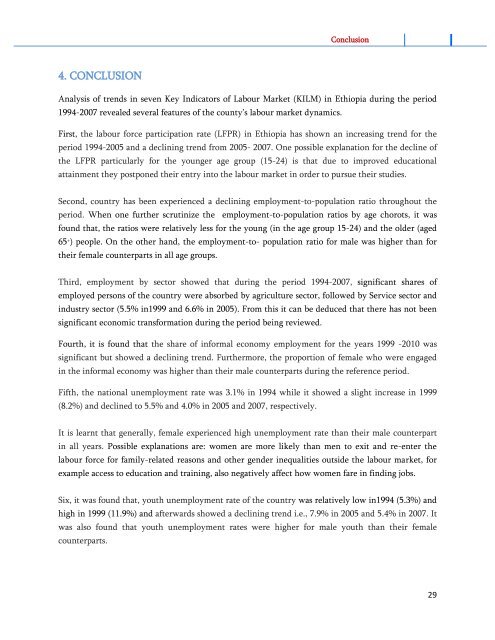Ethiopia KILM
Ethiopia KILM
Ethiopia KILM
- No tags were found...
Create successful ePaper yourself
Turn your PDF publications into a flip-book with our unique Google optimized e-Paper software.
Conclusion<br />
4. CONCLUSION<br />
Analysis of trends in seven Key Indicators of Labour Market (<strong>KILM</strong>) in <strong>Ethiopia</strong> during the period<br />
1994-2007 revealed several features of the county’s labour market dynamics.<br />
First, the labour force participation rate (LFPR) in <strong>Ethiopia</strong> has shown an increasing trend for the<br />
period 1994-2005 and a declining trend from 2005- 2007. One possible explanation for the decline of<br />
the LFPR particularly for the younger age group (15-24) is that due to improved educational<br />
attainment they postponed their entry into the labour market in order to pursue their studies.<br />
Second, country has been experienced a declining employment-to-population ratio throughout the<br />
period. When one further scrutinize the employment-to-population ratios by age chorots, it was<br />
found that, the ratios were relatively less for the young (in the age group 15-24) and the older (aged<br />
65 + ) people. On the other hand, the employment-to- population ratio for male was higher than for<br />
their female counterparts in all age groups.<br />
Third, employment by sector showed that during the period 1994-2007, significant shares of<br />
employed persons of the country were absorbed by agriculture sector, followed by Service sector and<br />
industry sector (5.5% in1999 and 6.6% in 2005). From this it can be deduced that there has not been<br />
significant economic transformation during the period being reviewed.<br />
Fourth, it is found that the share of informal economy employment for the years 1999 -2010 was<br />
significant but showed a declining trend. Furthermore, the proportion of female who were engaged<br />
in the informal economy was higher than their male counterparts during the reference period.<br />
Fifth, the national unemployment rate was 3.1% in 1994 while it showed a slight increase in 1999<br />
(8.2%) and declined to 5.5% and 4.0% in 2005 and 2007, respectively.<br />
It is learnt that generally, female experienced high unemployment rate than their male counterpart<br />
in all years. Possible explanations are: women are more likely than men to exit and re-enter the<br />
labour force for family-related reasons and other gender inequalities outside the labour market, for<br />
example access to education and training, also negatively affect how women fare in finding jobs.<br />
Six, it was found that, youth unemployment rate of the country was relatively low in1994 (5.3%) and<br />
high in 1999 (11.9%) and afterwards showed a declining trend i.e., 7.9% in 2005 and 5.4% in 2007. It<br />
was also found that youth unemployment rates were higher for male youth than their female<br />
counterparts.<br />
29


